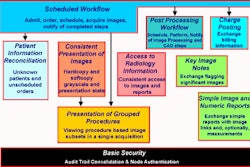
This is the first article in a regular AuntMinnie.com series tracking Bayonne Medical Center, a small community hospital in Bayonne, NJ, as it plans and implements an enterprise-wide PACS network.
Sometimes PACS is a strategic imperative. That's the case at Bayonne Medical Center (BMC), a 276-bed community hospital that's embarked on an aggressive PACS purchase and implementation plan. Driving the hospital’s actions is the promise of improved efficiency and access to radiology images and information.
"Today's physician practitioners have so many demands placed on them that out of necessity they're coming to us and asking us to go faster and provide higher-quality service," said Patrick Giordano, executive director of imaging and vascular services at BMC. "We just can't achieve that any longer in a conventional film-based mode."
Based on these imperatives, BMC administration did not require a formal needs assessment or cost-justification process for PACS. While cost is always an issue in today's healthcare environment, the benefits of improved service and patient satisfaction associated with PACS were more important than pure financial concerns, he said.
 |
| The transition to PACS is a necessary strategic decision for Patrick Giordano, Bayonne Medical Center’s executive director of imaging and vascular services. |
BMC returned to profitability in 2001 after several years of losses, and is in the midst of a growth spurt. In February, BMC changed its name from Bayonne Hospital to reflect its expanded scope and breadth of services, including the planned opening of a vascular center and completion of an extensive renovation of its emergency department. In line with projected growth in the community, BMC expects to increase its bed capacity by more than 30%, and has planned additional investment in several clinical departments, including radiology.
This growth, combined with a 60% Medicare patient population and a sizeable managed care base, necessitates a high level of efficiency, according to Giordano. PACS can help in this quest by offering dramatically improved service to referring physicians and patients, he said.
The BMC radiology department performs 90,000 procedures per year, a figure that's projected to grow by 5% to 10% annually. The unit currently has two CT systems, one MRI scanner, a diagnostic and vascular ultrasound service, two mammography systems, a nuclear medicine system, a radiation oncology service, and seven x-ray rooms (four fluoroscopy units and three conventional radiography units). The department also has three portable C-arms and three conventional portable radiography units.
 |
| BMC expects that PACS will lead to improvements in service to referring physicians. |
BMC is planning to acquire a multi-row detector CT unit and a high-field open MRI scanner this year, purchases that are helping to spark a speedy PACS implementation process, Giordano said.
The PACS purchasing process began in February after the facility retained PACS consulting firm SG&A Consulting of Arlington, TX. The PACS planning team is led by Giordano and includes representatives from the BMC information technology department, several radiologists, and various referring physicians, he said.
Foregoing an RFP
Giordano, BMC, and Stuart Gardner of SG&A Consulting have elected not to pursue the traditional request for proposal (RFP) model for acquiring PACS. With the rapidly evolving nature of PACS technology, RFPs can be too rigid to accommodate industry changes, Giordano said.
"We don't want to exclude ourselves from technology advances," he said. "We defined our specifications and have decided that's the way we'll present our needs to the vendors."
Giordano and SG&A have whittled down the prospects to five vendors, who have been making presentations the first two weeks of April at BMC. Following the presentations, this list will likely be trimmed to a short list of vendors. At that point, the BMC team will embark on site visits, with final vendor selection targeted for May.
After that, BMC hopes to complete the first phase of implementation by autumn 2002. This phase will include archiving for CT and ultrasound and Web-based distribution to on-call radiologists and referring physicians. The facility would also like to achieve integration of the PACS with its legacy RIS in the first phase, to offer worklist capability and avoid manual input of patient information, he said.
"We know it's an aggressive timetable, but it's being partly driven by our acquisition of our CT, which is capable of collecting a high volume of data and requires us to be able to handle that data appropriately," he said.
In the second and third phases, the PACS network would be expanded to include the cardiology department, all of the remaining digital imaging modalities, and the addition of computed radiography or digital radiography systems (replacing current analog units), he said. Depending on availability of funding, BMC hopes to complete the project in 2003, Giordano said.
By Erik L. RidleyAuntMinnie.com staff writer
April 11, 2002
Next month: Vendor presentations.
Copyright © 2002 AuntMinnie.com



















